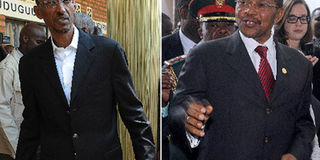Is Tanzania on its way out of the East African bloc again?

Presidents Paul Kagame of Rwanda (L) and Jakaya Kikwete of Tanzania (R). Until recently, there were fears that Tanzania would withdraw from the East African Community. Tanzania found itself on a collision course with Rwanda when President Kikwete ordered for the return of Rwandan refugees and business people who had been staying at the north-western Tanzania for years. PHOTO/FILE
What you need to know:
- President Jakaya Kikwete deflated the tension when he gave the assurance that his country, Tanzania, was in EAC to stay.
- In early November, Tanzania threatened to pull out of EAC in protests against the move by other partner states – Kenya, Uganda and Rwanda – to form a “coalition of the willing” and come up with bilateral projects in exclusion of Tanzania and Burundi.
Until early November, there were fears that Tanzania would withdraw from the East African Community (EAC) following isolationist moves by other partner states of Kenya, Uganda and Rwanda.
But President Jakaya Kikwete deflated the tension when he gave the assurance that his country, Tanzania, was in EAC to stay.
However, he admonished those who appeared keen on isolating Tanzania.
Analysts were worried of a repeat of the break-up in 1977, when the EAC collapsed because of, among other things, the ideological differences between Jomo Kenyatta and Julius Nyerere.
It is now emerging that regional security issues and politics revolving around the Democratic Republic of Congo, as well as the cases facing President Uhuru Kenyatta and his deputy William Ruto, were some of the factors at play.
Secondly, while Tanzania is emerging as a new darling of the West, a regional economic powerhouse and an ideal investment destination, Kenya, Rwanda and Uganda that previously had the favoured national status, have of late faced accusations of putting or attempting to put in place stringent media laws that go against freedom of expression and human rights.
Uganda’s President Yoweri Museveni, for instance, has been accused of high handedness in dealing with the opposition and independent press.
It is instructive to note that two US presidents – George Bush and Barack Obama – have visited Tanzania but not any other country in the region.
In early November, Tanzania threatened to pull out of EAC in protests against the move by other partner states – Kenya, Uganda and Rwanda – to form a “coalition of the willing” and come up with bilateral projects in exclusion of Tanzania and Burundi.
Trade relations
The Minister for East African Co-operation Samuel Sitta, had on October 30 told Parliament that Tanzania was seeking stronger economic and trade relations with the Democratic Republic of the Congo and Burundi, after being slighted by Kenya, Uganda and Rwanda.
Presidents Uhuru Kenyatta, Paul Kagame of Rwanda, Uganda’s Yoweri Museveni and Salva Kiir of South Sudan signed a host of protocols and agreements in Kigali, including free movement of goods and persons, common entry visa, infrastructural development and transformation into a single customs union.
The three countries have perceived Tanzania as an impediment to regional integration.
Among the accusations against Tanzania are lacklustre commitment towards the actualisation of the EAC, creating delays in moving the union to faster integration by continually erecting new non-tariff barriers (NTBs).
However, Tanzania’s beef, especially according to President Jakaya Kikwete, is that “the coalition of the willing” is going ahead and discussing the implementation of issues that have been put on the table at the EAC and which cannot be implemented unilaterally by partner states.
His main concern is that the three countries want to fast-track political federation, which, according to Tanzania, cannot come before the monetary union.
The tension started in May when President Kikwete called on Rwanda to hold talks with the Democratic Forces for the Liberation of Rwanda (FDLR) rebels, who had been blamed as the perpetrators of the 1994 genocide but have been holed up in eastern Congo.
Speaking at a summit to tackle security issues on the continent in the sidelines of the 50th Anniversary of the African Union (AU) celebrations in Addis Ababa, President Kikwete also called upon President Yoweri Museveni of Uganda to hold talks with the rebels from the Allied Democratic Forces-National Army for the Liberation of Uganda (ADF-NALU) that is opposed to his government.
While Uganda took the suggestion lightly, Rwanda went ballistic.
Rwanda’s Minister of Foreign Affairs, Louise Mushikiwabo said Rwanda would not consider negotiating with people who were responsible for the 1994 genocide. She accused President Kikwete of sympathising with FDLR.
Soon after, Tanzania again found itself on a collision course with Rwanda when President Kikwete ordered for the return of Rwandan refugees and business people who had been staying at the north-western Tanzania for years.
Rwanda interpreted the move as a revenge for the harsh tone Kigali had taken over Kikwete’s suggestion for talks with rebels.
It was therefore not surprising that Kikwete wondered loudly whether the move to form “the coalition of the willing” was driven by personal hatred against him or not.
The international community, including the United Nations, has often accused Rwanda and Uganda of promoting instability in eastern Congo by supporting rebel groups in the area.
In the late 1990s, Rwanda and Uganda joined forces with Laurent Kabila to drive out Mobutu Sese Seko. A few years later, Uganda and Rwanda forces re-entered Congo, then with the objective of ousting Kabila, forcing Angola and Zimbabwe to come to Kabila’s rescue.



